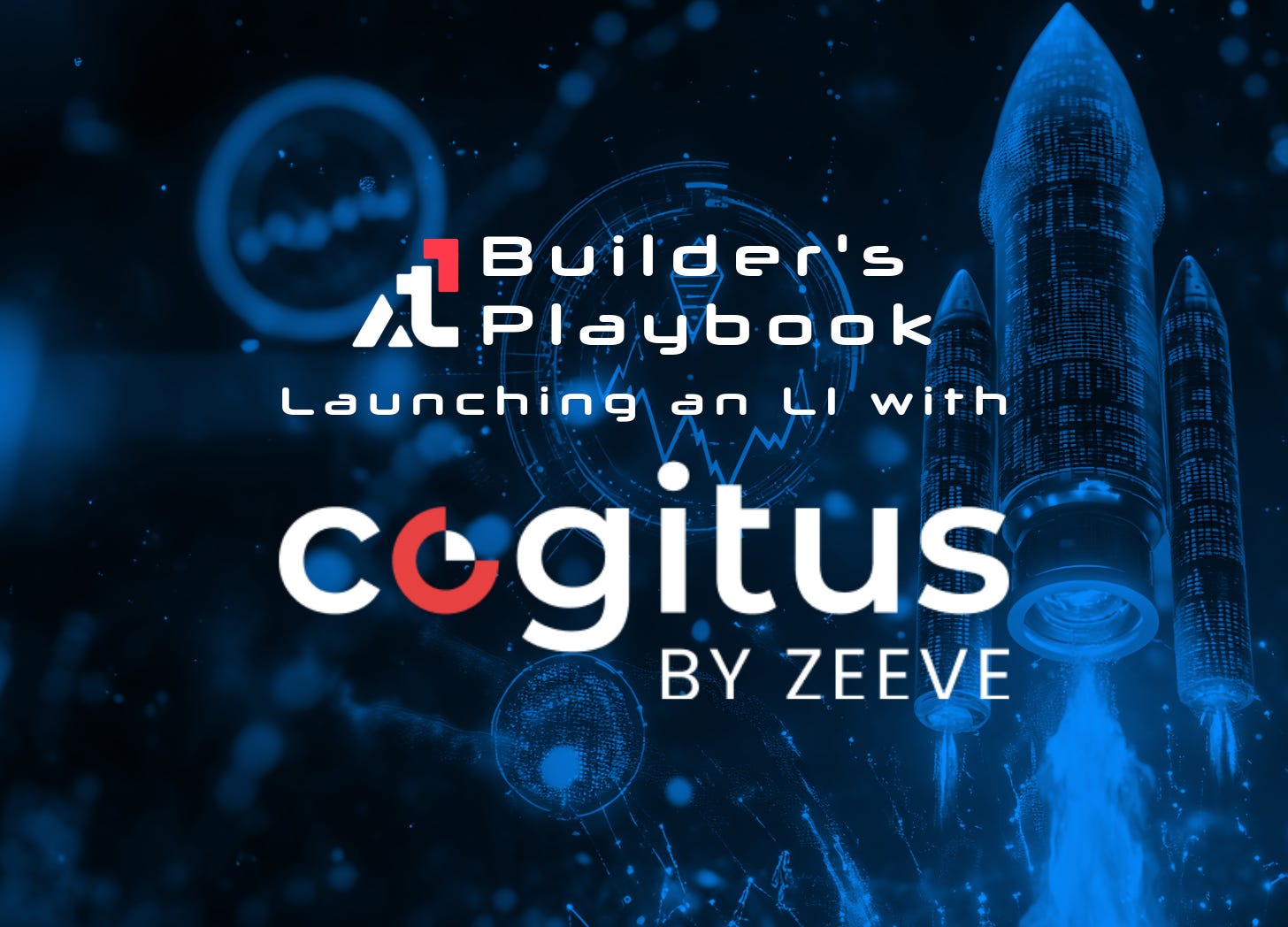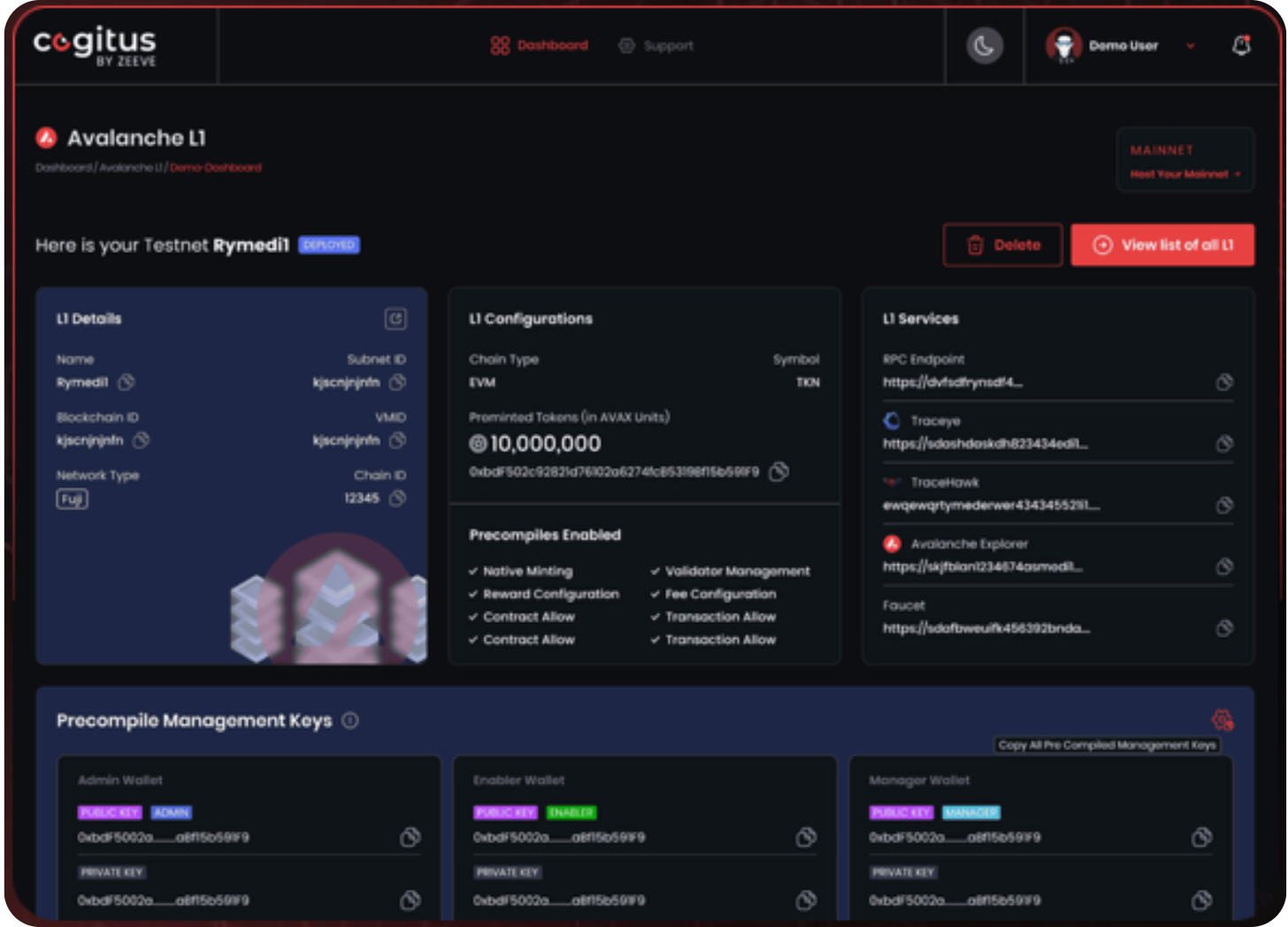A Builder’s Guide to Launching Avalanche L1s with Cogitus
Learn how teams are moving from idea to mainnet on Avalanche with no setup stress, better infra choices, and fewer delays.
Teams building across Web3 are increasingly choosing to launch their own L1s on Avalanche. One tool that’s powering a growing number of those launches is Cogitus.
Built by Zeeve, Cogitus has helped over 15 projects spin up production-ready chains in the past 90 days. It has become a go-to choice for teams that want to move fast without getting stuck in DevOps setup or with fragmented tooling.
In June alone, Avalanche chains processed over 515 million transactions, marking the best-ever month across all indexed L1s. From DeFi and gaming to DePIN, RWA, and AI agents, projects are increasingly opting for full-stack control, flexible execution, and ecosystem-level interoperability.
Around 84 Avalanche L1 mainnets, excluding the primary Avalanche network, are now live. In the past 90 days, more than 15 of those launched using Cogitus, including projects like The Binary Holdings, CodeNekt, Watr, Fizit, DCOMM, and GrowFitter.
These teams didn’t start out wanting to launch a chain. They started with a problem.
— Congested shared networks
— High gas volatility
— Platform control
— Data isolation & compliance
— Ecosystem alignment
Gradually, a chain became the most pragmatic solution.
So, what are these teams really looking for in an Avalanche L1? What are the biggest blockers? And what’s shifting in how chains are launched and used?
Let’s take a closer look at what teams are actually solving for and how Avalanche fits in.
Why Avalanche Makes Sense
Teams across Web3 are using Avalanche to launch L1s because it gives them more control and better performance. Here’s why:
First, it gives builders full-stack sovereignty. You can define your own gas logic, VM, tokenomics, validator framework, governance, and choose a privacy-preserving token standard (eERC20) —something that's simply not possible in shared environments where sequencers are centralized and execution is restricted.
Second, Avalanche eliminates the fragmentation problem that typically plagues sovereign chains. With native support for Interchain Messaging Protocol (ICP) and Interchain Asset Movement (ICM), chains can remain sovereign yet interoperable, bridging users, liquidity, and logic as needed.
Third, Avalanche’s ecosystem support goes beyond grants. Programs like Avalanche9000, and InfraBUIDL actively help projects with infra credits, validator onboarding, and go-to-market guidance. Builders don’t just get tech, they get direction and distribution.
Fourth, Avalanche has quietly become one of the most performant L1 ecosystems in production. Average daily TPS exceeded 222, with close to 20M transactions recorded in a single day and 2.6 trillion in gas used, yet gas costs remain near all-time lows. For teams building at scale, this balance between high throughput and cost efficiency is a critical factor.
And finally, Avalanche offers an option for true decentralization of an L1. Chains like Beam have already sold thousands of validator node licenses as NFTs and now operate with over 320 active validators. This level of validator diversity and community-run security is nearly impossible to achieve through other modular stacks or layered blockchain solutions.
What Makes Launching a Chain Difficult
These are some of the most common roadblocks teams run into when launching their own L1s:
1. Lack of Unbiased Advisory on Tech Stack Fit
Every product is different, and so is the ideal chain configuration. But most teams only realize this after spending months trying different options, working with biased providers, and rolling back failed setups.
2. DevOps Bottlenecks from the Start
Teams underestimate the complexity of setting up a live network. Just to launch a testnet, you need to configure consensus, build RPC and validator infra, manage YAMLs, spin up explorers, and deploy dashboards. This delays the launch by weeks—or worse, derails it entirely.
3. Missing or Fragmented Tooling
A working L1 isn’t usable until it’s integrated with oracles, bridges, wallets, indexers, and data layers. Builders are left hunting for plug-ins, patching in SDKs, or building tooling from scratch, causing further delays and UX fragmentation for devs and users.
4. The Infra Costs Are >60% Higher in Most Cases.
Most teams end up spending far more than necessary just to get their chain online. Often 60% higher for ongoing management costs. And if teams try to manage things in-house, they’re forced to stack vendors for hosting, monitoring, dashboards, to add integrations, only to end up with even more burn and less control. For early-stage chains, it’s a serious drag on momentum.
5. High-Risk Migrations from Other Chains
Several projects migrating to Avalanche bring live testnets or active apps from other chains. However, migrating full state, infrastructure, and community tooling without data loss or downtime is a significant challenge, and most providers aren’t prepared to support that kind of migration.
How Teams Are Using Cogitus to Launch Faster
Launching a chain still comes with real setup hurdles. Cogitus gives teams a way to go live without building the entire infra stack from scratch. Teams use Cogitus to configure their chains with custom consensus, virtual machine, validator rules, gas logic, and token setups without spending weeks setting up tooling and infra from scratch..
Once live, everything from validator infra and L1 management dashboards to data indexing, uptime monitoring, and even co-marketing and launch support is provided. It’s designed to reduce setup time, avoid DevOps overhead, and give teams a smooth path from idea to chain launch.
Explore the full suite of services in the documentation.
But beyond launch automation and a comprehensive suite of tools and managed services, Cogitus also unlocks some serious advantages for Avalanche L1 builders.
First, compliance and operational trust matter more than ever, especially for teams in regulated verticals like RWA or enterprise networks. With compliant infrastructure (SOC 2 Type 2, ISO 27001, GDPR), 24/7 proactive monitoring, and SLAs with guaranteed 99.99% uptime, platforms like Cogitus give teams the confidence to scale without worrying about audit readiness or uptime risks.
Second, their integration readiness is a major timesaver. From oracles and bridges to identity, wallets, and indexers, Cogitus offers a growing list of on-demand integrations, like Redstone, Hyperlane, Thirdweb, Palmera, Privado Id, and dozens more. These integrations help teams avoid weeks of custom setup and allow developers to go live with the tooling they actually need.
Finally, we’ve seen a rise in demand for community-driven fundraising/validation models since last year, especially among consumer-facing or tokenized networks like Beam L1. Cogitus provides infra support for validator license sales via NFTs, letting teams turn early supporters into network validators while bootstrapping decentralization and token lockup from the start.
What We’re Seeing Next:
Avalanche is entering a new phase. It’s not only about metrics like TPS or validator count. What matters is who’s building and what they need.
AI agents require fast finality and parallel execution, while DePAIs necessitate sovereign control, RWA, and enterprise platforms that demand compliance, uptime, and auditability. These are real businesses that are choosing Avalanche L1s for their distribution.
As more of these use cases come online, the demand for Avalanche-native infra is only going up. Tools like Cogitus are part of what’s making this new wave of Avalanche L1s possible. They help teams skip the heavy lift and focus earlier on users, apps, and growth.
Explore More: Cogitus Website
Dive into the Avalanche ecosystem today! Download the Core Wallet and unlock a world of seamless DeFi, NFTs, and more.








adoption!
"Around 84 Avalanche L1 mainnets, excluding the primary Avalanche network, are now live. In the past 90 days, more than 15 of those launched using Cogitus, including projects like The Binary Holdings, CodeNekt, Watr, Fizit, DCOMM, and GrowFitter."
This implied that Zeeve launched 15 L1s out of those 84 L1s on Mainnet. Zeeve by total never launched 15 L1s on Mainnet, let alone last 90 days. Either Zeeve lied or the author was given misleading info. Please have it verified and corrected.